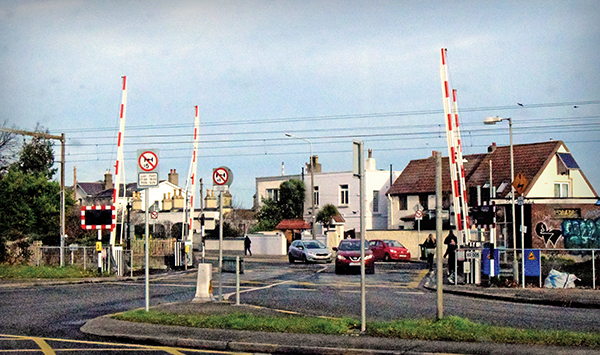
Merrion Gates junction.
Photo: Kevin O’Gorman.
A study has been carried out by the National Transport Authority (NTA) which advocates a number of improvements at Merrion Gates to alleviate the bottleneck in order to solve both the traffic congestion problem as well as to make the area safer.
A public consultation was held on November 23rd in Tara Towers Hotel, where the plans were shown and explained to members of the public.
According to Hugh Creegan, Deputy Chief Executive of Director of Transport Investment and Taxi Regulation, this proposal has been sought for some time. Part of the plans are to build a cycle path from Sutton to Sandycove. The cycle path on the northside is nearing completion from Sutton to Clontarf. However, developments south of the Liffey are limited.
An issue of contention is the Natura 2000 site, an ecologically important animal habitat along the coast, which is protected under European environmental law. The precedents set under European law have scuppered development plans for the cycle path in the past. Creegan feels that this proposal is now in line with EU environmental law as it does not protrude into the bay but rather uses the already built-upon land near the coast.
By 2017, the DART frequency will be every 10 minutes, in principle, according to NTA. As there is a level crossing at Merrion Gates this poses a problem. Currently the frequency of the DART causes delays of around 20 minutes because traffic has increased in recent years. However, if DART trains come every 10 minutes, instead of their current 15 minute interval, this could cause delays of up to 40 minutes.
In addition, to these delays to traffic, there are other issues. People trying to outrun the gates as they close when a DART is due, is dangerous and can often cause the signal box to be damaged. This delays the service all along the line. In addition, the cars can be queued in such a way that the gates can not go down, which has the same effect on the service.
To prevent this from happening, the plans propose to build a bridge that would act as a buffer beside which people can walk and then move the road to take traffic away from the level-crossing, which would be closed off. To facilitate this, a bypass would be built from Strand Road to Merrion Road. Sealing off the gates will also have the effect of preventing people trying to outrun the gates coming down.
The other safety concern is that the current junction between Merrion Road and Strand Road is at an acute angle and presents dangers for cyclists. It is hoped that the overpass will solve this issue by ensuring that traffic would be arriving on Merrion road in a less acute manner but rather more gradually. An integral part of this design is clear lanes created for cyclists, walkers and cars, while DART traffic is overpassed and detoured. Submissions from the public have now closed.
By Kevin Mac Sharry



